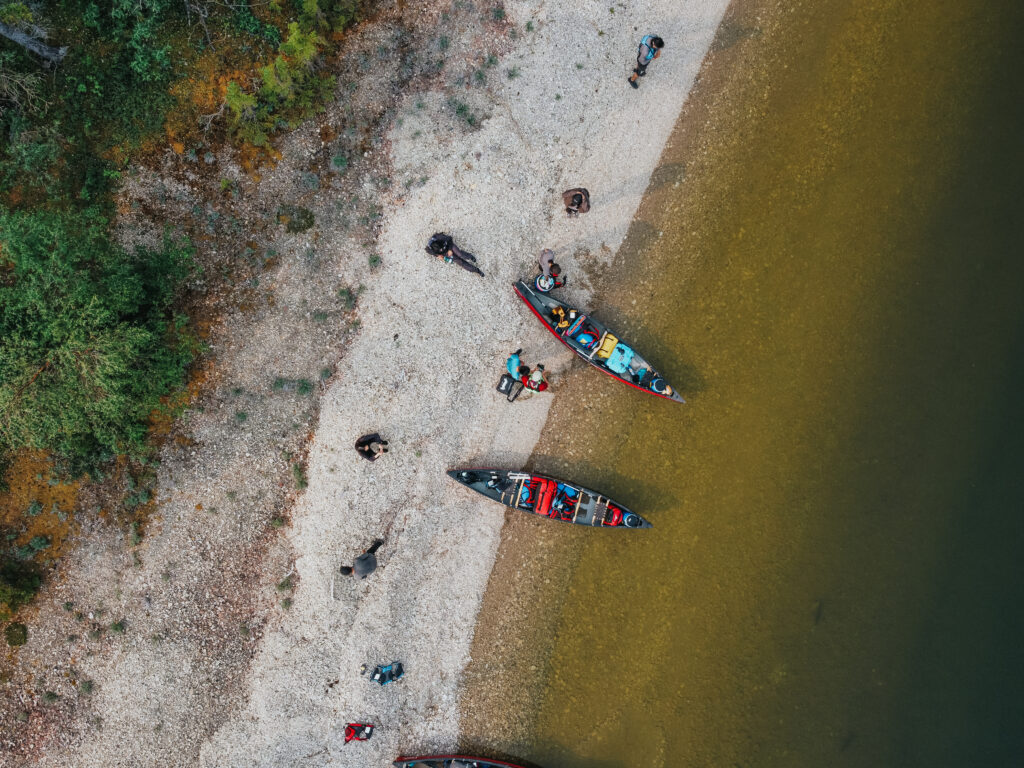The Indigenous Land-Camp Experience, An Inside Look
February 16, 2023
When people think of STEM, they often imagine sitting in a laboratory or classroom, mastering complex theories. However, there’s another way to think about STEM: land-based learning.
The land has always been the classroom for Indigenous people. Whether it be harvesting an animal for food, plants for medicine, or building a sweat lodge to conduct ceremonies, these activities are central to teaching youth critical life skills. Contrary to common belief, these aspects of Indigenous culture are embedded with high knowledge of STEM, such as biology, chemistry, mathematical formulas, and engineering design concepts. That’s why Actua believes Indigenous land-based learning, which assumes an environmental approach to learning, offers Indigenous students a relevant, meaningful, and culturally-appropriate way to learn about STEM and gain critical skills and confidence.
For over 25 years, Actua, in partnership with hundreds of Indigenous Elders, Knowledge Keepers, educators and thought leaders in STEM, has engaged Indigenous youth in culturally relevant STEM experiences across Canada as part of our Indigenous Youth in STEM (InSTEM) program. Many of these experiences leverage land-based learning as a means to engage Indigenous youth.
So, what does a land-based STEM camp actually look like? To give you an idea, let’s zoom in on a series of camps that ran through July and August of last year in Canada’s Sahtu region, which encompasses five communities in the Northwest Territories.
Actua’s For-Credit Land Camps in Sahtu
This past summer, Actua partnered with Black Spruce Education to deliver land-based programs in the Sahtu region, which consisted of three different day camps and two canoe trips that engaged youth in grades 3-11. The camps were made possible with support from the Future Skills Centre and Imperial.
Day Camps
Day camps engaged younger youth in technology and coding, engineering and design, environmental science, and many other STEM subject areas through hands-on land activities. The camp focused on creating space for youth to connect to local and/or Indigenous Knowledge and leveraged local community members such as biologists, artists and mathematicians. For example, two of the activities run at the day camps include:
Activity #1: Beading Molecules – The Double Helix of a Life
In this activity, participants learned about the structure of DNA and the diversity of life at the molecular level through an Indigenous beading activity. Participants beaded a double helix model while learning how to:
- follow the experimental procedure and extract DNA;
- compare DNA among various species and understand the complexity of the DNA structure; and
- better understand the community of beadwork and the STEM embedded in it.
The activity also illustrated how STEM is embedded in traditional Indigenous activities. For example, throughout this activity, participants learned that needles are a technology, crafting is a form of engineering, and patterns are mathematically inclined. They also learned how beading brings together the community by sharing patterns, ideas and support.
Activity #2: Canoe Kit Build & STEM Activity (The Role of Density & Buoyancy in Boats)
In this activity, participants learned about the traditional canoe and the concepts of water resistance, buoyancy, density and centre of gravity while practicing scientific investigation, experimentation and the engineering design cycle.
By first building a small-scale canoe using sustainably harvested bark, participants treated the wood and explored the lacing methods used to create the canoe’s shape and the methods used to create a stable, buoyant and waterproof structure. They then used their knowledge and experience building the model canoe to design their boat to address various design considerations such as speed and stability.
Youth also learned about the canoe’s history and its critical role in Indigenous culture and were engaged in the discussion surrounding traditional harvesting practices and Indigenous stewardship.
Canoe Trips
Canoe trips targeted older youth and enabled them to interact with various scientific tools and concepts while completing a canoe trip and cultural activities led by community members. The primary focuses of Actua’s role in the canoe camps were demonstrating the effectiveness of land-based learning and providing youth with the opportunity to connect their cultural knowledge to STEM. High-school students participating in the canoe trips were eligible to receive a high-school credit upon completion of the camp.
Activity #1: Community Mapping
Mapping can be a powerful tool to connect individuals and share stories. In this activity, participants explored their knowledge of their community by creating a community map. Participants were encouraged to think about their community and where they may already know STEM exists, marking those connections on the community map and sharing their stories and experiences with their peers. Participants explored different mapping styles and technologies and were encouraged to recognize their existing skills by bringing their cultural practices and understandings to the camp space.
Activity #2: A Deeper Look – Climate Change in Aquatic Food Webs
In this activity, participants aimed to understand the impact of climate change on our environment with a specific focus on lakes and aquatic food webs. Through a fictional scenario, participants conducted a series of experiments to determine the source of contamination and brainstorm how this would ultimately affect an aquatic ecosystem. This activity highlighted the work chemists, water testers and community members play in maintaining the health and integrity of aquatic ecosystems.
Participants explored the impacts of climate change on animal species and bodies of water, which has a direct impact on many Indigenous communities. This activity also offered participants an opportunity to discuss these impacts while exploring how STEM and community knowledge can come together to monitor and inform environmental conservation efforts.
A message from our supporters
“Indigenous people remain underrepresented in STEM fields, creating a barrier for Indigenous youth who can’t see themselves in STEM,” said Laura Bishop, Communications & Social Investment Manager at Imperial. “Through our partnership with Actua, we’re proud to provide Indigenous youth with a unique learning opportunity that connects their traditional cultural knowledge with modern STEM, creating a path for them to be future leaders in the field.”





